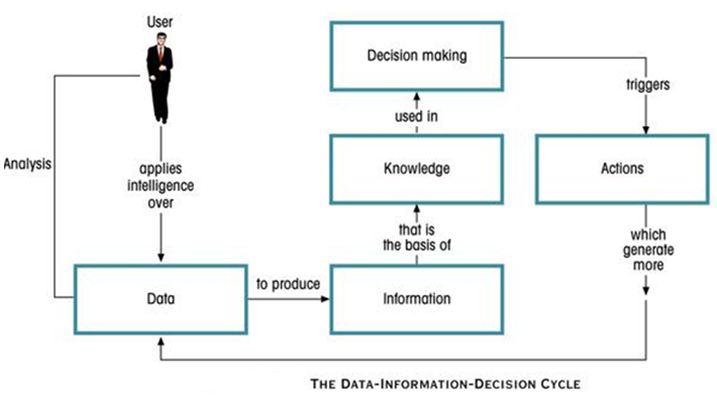Data as a Corporate Asset:
Data viewed as a company asset for two reasons:
1. There were simply too many data to be processed manually
2. Internal and external business operations moved at a much slower pace than they do today, so there was relatively little need for quick reactions triggered by fast-flowing information.
Data are a valuable resource that can translate into information. If the information is accurate and timely, it is likely to trigger actions that enhance the company’s competitive position and generate wealth. In effect, an organization is subject to a data-information-decision cycle; that is, the data user applies intelligence to data to produce information that is the basis of knowledge used in decision making by the user. This cycle is illustrated in the following figure.
You May Also Like:
Role of Databases in An Organizations
Summary of DBA Activities
DBA Evoluation
DA and DBA
The decisions made by high-level managers trigger actions within the organization’s lower levels. Such actions produce additional data to be used for monitoring company performance. In turn, the additional data must be recycled within the data-information-decision framework. Thus, data form the basis for decision making, strategic planning, control, and operations monitoring.

As organizations become more dependent on information, the accuracy of that information becomes ever more critical. Dirty data, or data that suffer from inaccuracies and inconsistencies, becomes an even greater threat to these organizations. Data can become dirty for many reasons, such as:
• Lack of enforcement of integrity constraints (not null, uniqueness, referential integrity, etc.).
• Data entry typographical errors.
• Use of synonyms and/or homonyms across systems.
• Non standardized use of abbreviations in character data.
• Different decompositions of composite attributes into simple attributes across systems.
Efforts to control dirty data are generally referred to as data quality initiatives.
Data quality is a comprehensive approach to ensuring the accuracy, validity, and timeliness of the data. Data quality is concerned with more than just cleaning dirty data; it also focuses on the prevention of future inaccuracies in the data, and building user confidence in the data. Large-scale data quality initiatives tend to be complex and expensive projects. While data quality efforts vary greatly from one organization to another, most involve an interaction of:
• A data governance structure that is responsible for data quality.
• Measurements of current data quality.
• Definition of data quality standards in alignment with business goals.
• Implementation of tools and processes to ensure future data quality.
There are a number of tools that can assist in the implementation of data quality initiatives. In particular, data profiling and master data management software is available from many vendors to assist in ensuring data quality. Data profiling software consists of programs that gather statistics and analyze existing data sources. These programs analyze existing data and the metadata to determine data patterns, and can compare the existing data patterns against standards that the organization has defined. Master data management (MDM) software helps to prevent dirty data by coordinating common data across multiple systems. MDM provides a _master_ copy of entities, such as customers, that appear in numerous systems throughout the organization.
You May Also Like:
Security of DBMS
Database Administration Tools
Denormalization
Back to DBMS Questions


